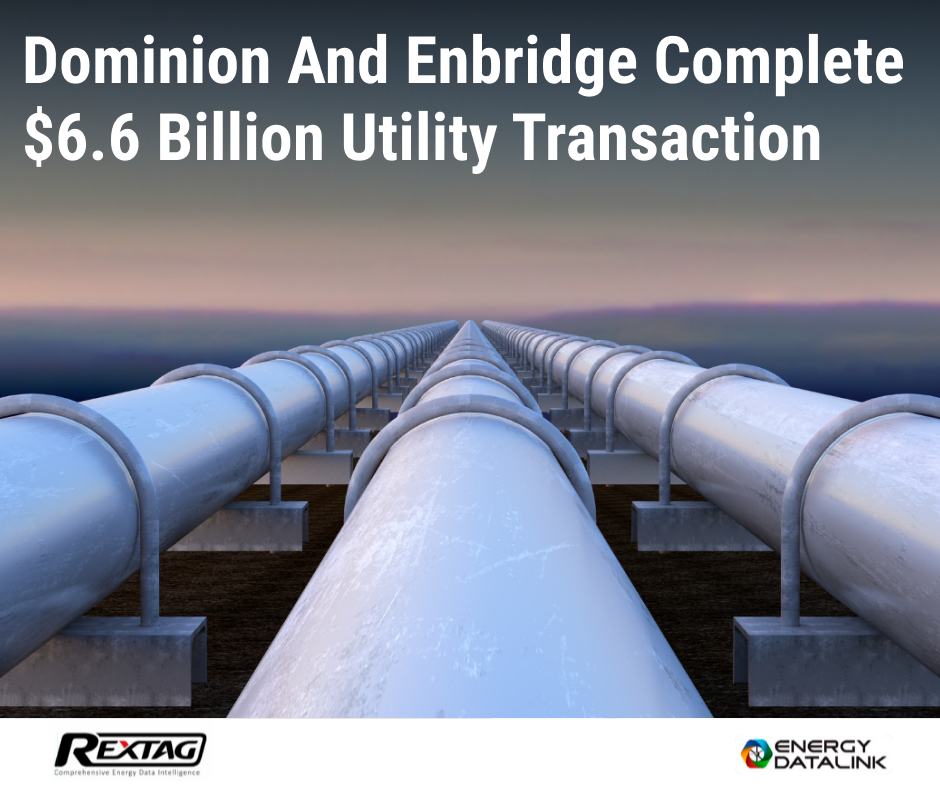Comprehensive Energy Data Intelligence
Information About Energy Companies, Their Assets, Market Deals, Industry Documents and More...
Dominion and Enbridge Complete $6.6 Billion Utility Transaction
03/20/2024
Enbridge Inc. has completed a $6.6 billion purchase of The East Ohio Gas Co., an Ohio natural gas company, from Dominion Energy. This acquisition is part of a larger $14 billion merger and acquisition deal previously announced by the two companies. The East Ohio Gas Co. will operate under the new name Enbridge Gas Ohio (EOG) and become part of Enbridge's Gas Distribution and Storage Business Unit, including taking on some debt as mentioned by Dominion.
EOG is set to provide over 40% of the yearly EBITDA expected from the three gas utilities Enbridge is buying from Dominion. The purchases of Questar Gas Co., Wexpro companies, and the Public Service Company of North Carolina from Dominion are still in progress, with Enbridge planning to finalize these in 2024 after getting the necessary regulatory approvals.
EOG serves over 1.2 million customers in Ohio alone, boasting a significant infrastructure network that includes over 22,000 miles of pipelines for transmission, gathering, and distribution, as well as underground storage and connections to several major interstate pipelines and natural gas producers.
Adding a big gas company from Ohio to Enbridge's business is a smart move. Michele Harradence, who leads Enbridge's gas distribution and storage, says this helps the company grow and keep making steady money. Gas companies are important because they provide safe and affordable energy that people need for a long time.
This new addition will help Enbridge make more money steadily until the end of the decade. It's a good investment that matches their plan to pay regular dividends to their shareholders. Also, with this purchase, Enbridge now works in all its business areas in Ohio, which means more chances to do well and make money.
Dominion Energy, with its headquarters in Richmond, Virginia, serves about 6 million customers across 15 states with electricity and natural gas. The company has set a commitment to achieve Net Zero emissions by 2050.
Rextag consistently monitors and compiles data on Natural Gas. Discover detailed insights in our exclusive ‘American Gas Data & Map Book’.
About Enbridge
Enbridge, based in Calgary, Canada, manages 30% of North America's crude oil transportation and nearly 20% of the US's natural gas, with the world's most complex liquid transportation system extending 17,809 miles. Following a significant acquisition in September 2023, it became North America's largest gas utility by volume. A pioneer in renewable energy, Enbridge is committed to achieving net-zero greenhouse emissions by 2050, focusing on sustainability and reducing emissions intensity by 35% by 2030. Its gas transmission network, vital for LNG exports, moves about 24.6 billion cubic feet of natural gas daily across key markets in North America.
If you are looking for more information about energy companies, their assets, and energy deals, please, contact our sales office mapping@hartenergy.com, Tel. 619-349-4970 or SCHEDULE A DEMO to learn how Rextag can help you leverage energy data for your business.
Pembina (PBA) to Acquire Enbridge's Joint Ventures for $2.3 Billion - C$3.1 Billion
![$data['article']['post_image_alt']](https://images2.rextag.com/public/blog/211Blog_Enbridge divests Alliance Pipeline and Aux Sable interests for 2.3B.png)
Pembina Pipeline Corporation PBA, a well-known player in the Canadian midstream sector, recently announced its plan to acquire Enbridge Inc.'s remaining shares in the Alliance Pipeline, Aux Sable pipelines, and NRGreen joint ventures. The deal, valued at C$3.1 billion or US$2.3 billion, marks a key step for Pembina in asserting its leadership in North America's natural gas transportation sector. This strategic acquisition is expected to considerably boost Pembina's growth and profitability in the coming years.
Cold Weather Disruptions Lead to Lower US Natural Gas Production in January 2024
![$data['article']['post_image_alt']](https://images2.rextag.com/public/blog/236Blog_Cold Weather Leads to Lower US Natural Gas Production (Jan 2024).png)
In January, US natural gas production dropped to 102 billion cubic feet per day (Bcf/d) from December's record of 106 Bcf/d due to bad weather. The Energy Information Administration (EIA) expects it to recover soon, hitting 105 Bcf/d by March. The EIA's outlook for 2024 predicts an average production of about 104 Bcf/d, slightly down from the earlier forecast of 105 Bcf/d. By 2025, production is anticipated to climb over 106 Bcf/d.
![$data['article']['post_image_alt']](https://images2.rextag.com/public/blog/328_Blog_Why Are Oil Giants Backing Away from Green Energy Exxon Mobil, BP, Shell and more .jpg)
As world leaders gather at the COP29 climate summit, a surprising trend is emerging: some of the biggest oil companies are scaling back their renewable energy efforts. Why? The answer is simple—profits. Fossil fuels deliver higher returns than renewables, reshaping priorities across the energy industry.
![$data['article']['post_image_alt']](https://images2.rextag.com/public/blog/327_Blog_Oil Market Outlook A Year of Growth but Slower Than Before.jpg)
The global oil market is full of potential but also fraught with challenges. Demand and production are climbing to impressive levels, yet prices remain surprisingly low. What’s driving these mixed signals, and what role does the U.S. play?
![$data['article']['post_image_alt']](https://images2.rextag.com/public/blog/326_Blog_USA Estimated Annual Rail CO2 Emissions 2035.jpg)
Shell overturned a landmark court order demanding it cut emissions by nearly half. Is this a victory for Big Oil or just a delay in the climate accountability movement?